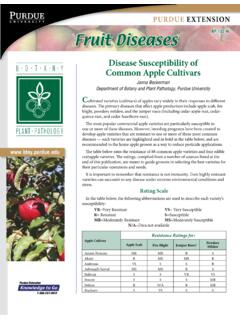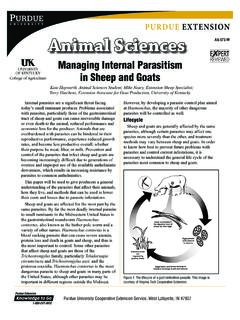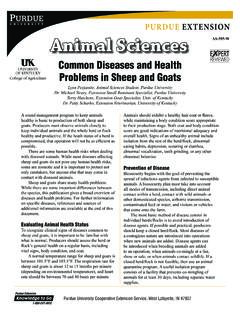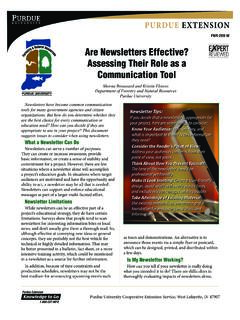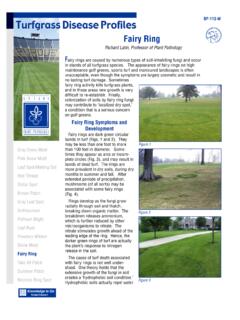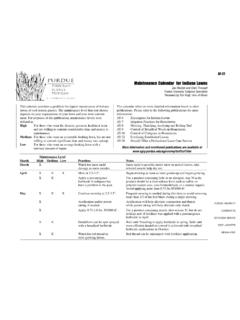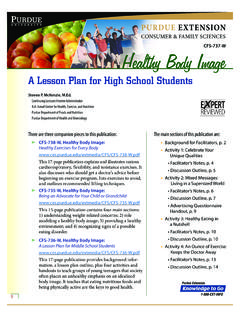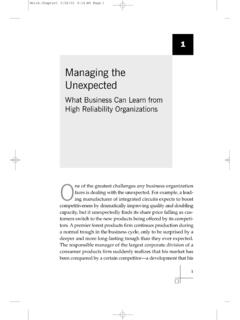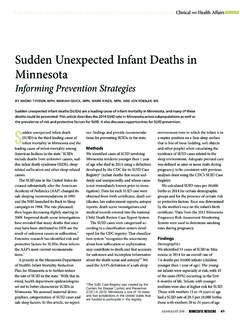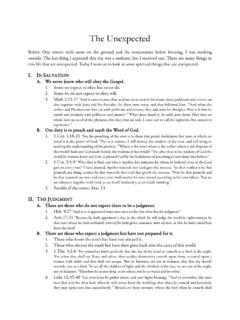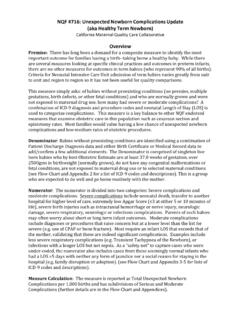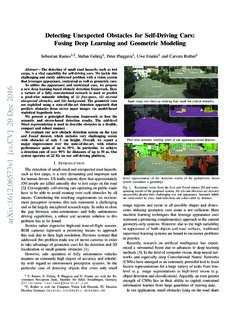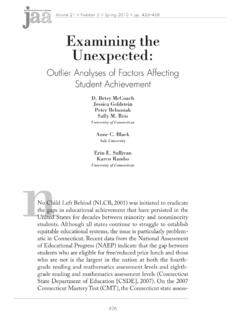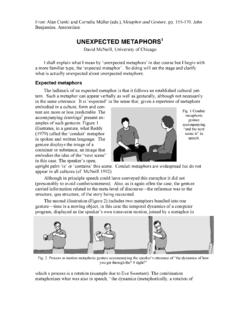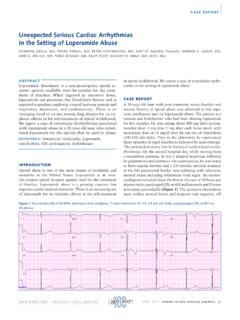Transcription of EC-736 Planning for the Unexpected: Human Resource Risk ...
1 Planning for the unexpected : Human Resource Risk and contingency Planning Maria I. Marshall and Corinne AlexanderDepartment of Agricultural EconomicsP u r d u e ex t e n s i o nEC-736 Small businesses are confronted by many different types of risk: production, marketing, financial, legal, and Human . Managers generally spend most of their time dealing with production, marketing, financial, and legal risks and give little consideration to Human Resource risk and how the absence of key personnel can affect their business. This is a serious oversight because people are the key component in many risk manage-ment Resource risks are events that prevent employ-ees from fulfilling their responsibilities and thus keep the business from operating at full efficiency. Human Resource risks include but are not limited to: Death Disability (temporary or permanent) Divorce Management Error/Incompetence unexpected Temporary Leave Poor Employee Management Practices Employee TurnoverOne way that you can combat Human Resource risk is by writing a contingency plan.
2 A contingency plan is a structured way of deciding what to do if key operations are disrupted or key personnel are not available. It can help you identify and prevent or modify the impact of unacceptable risks . It helps you recognize the best pos-sible options and ensures that your risk management dollars are spent wisely. Writing a contingency PlanA contingency plan is a set of procedures that defines how a business will continue or recover its critical func-tions in the event of an unplanned disruption to normal activities. It allows you to assess your business opera-tions and processes to determine how well the busi-ness can function when key resources, such as critical personnel, are not available. When writing your contingency plan you should use the knowledge and input of your business s key employees and outside stakeholders, such as your banker, accoun-tant, insurance agent, and lawyer.
3 You may also want to include family members who are not currently involved in the business but may have a future interest. You should establish a Planning team in order to share the responsibility among key personnel. This is important because key employees and other team members will be a critical part of any recovery strategy that you put together. An added advantage of including employees in your Planning team is to reassure employees that their jobs are secure even as you are preparing and imple-menting the plan. A contingency plan consists of six main sections: Executive Summary Risk Management Goals Risk Assessment Business Impact Analysis Risk Management Strategies Plan MaintenancePurdue Extension Knowledge to Go Writing a contingency plan is a continuous process. Once you decide which risk management strategies make sense for your business, you may need to re-assess the risks in your original plan.
4 You should not be dis-couraged if this causes you to rewrite several sections. This often leads to an even better understanding of your business and how everyone in it fits together. The execu-tive summary is the first section of your contingency plan. However, it is the last section you should write and so is discussed at the end of this publication. Risk Management GoalsIn this section, you should identify your risk manage-ment goals. The purpose of risk management goals is to reduce uncertainty. For example, you may want to reduce employee absence or accidents, which reduces uncertainty about labor availability. Risk management goals can also be about managing business opportuni-ties. For example, you may want the business or farm to stay within the family, which reduces uncertainty about the continuation of the business.
5 Risk management goals help you decide which opportunities and risk management strategies to AssessmentThis section of the contingency plan is about identify-ing and assessing the risks to the business. You should pinpoint the events that could cause financial or opera-tional harm to the business. For each event, evaluate both the probability of occur-rence and the consequence or impact of occurrence on a scale of 1 to 10, where 1 is low and 10 is high. You can think of the consequence of the event both in terms of severity and cost to the business. The first event in Table 1 is an owner of a business identifying as a possible risk a car accident that prevents or her from fulfilling her normal duties for six weeks. The owner rates the prob-ability of a car accident at between 2 and 3. She rates the consequence of being unable to fulfill her duties for six weeks at 8.
6 Use Worksheet 1 to list the events that pose a threat to your business. Figure 1. The Risk MatrixOnce you have rated the probability and consequences of each event, you can place them all on the risk matrix as shown in Figure 1. In event 2, the owner passes away; he is 80 years old and did not write a succession plan. The owner rates the probability very high at 8 and the consequence also very high at 8. Event 2 demonstrates the importance of succession Planning . If the 80-year-old business owner had a succession plan, the conse-quences to the business would be reduced to around 2. Introducing a succession plan moves the location of event 2 on the risk matrix from high consequence to low consequence, as shown by the arrow. Part of successful contingency Planning is to identify areas in which risk management, such as succession Planning , is the probability and consequence (severity, cost) of each event on a 1-10 scale (1=Low, 10=High).
7 Event Probability Consequence1. Owner in car accident, out 6 weeks .. 2-3 .. 82. Owner, 80, passes away .. 8 .. 83. Owner, 35, passes away .. 1 .. 104. New employee quits .. 3 .. 35. Employee injured on farm equipment .. 5 .. 5 Table 1. Risk Assessment List: What risks Does Your Enterprise Face? Purdue Extension Knowledge to Go In event 3, a young owner (35 years old) passes away. The owner rates the probability very low at 1, but believes the consequences for the business will be dev-astating at 10. Event 4 identifies the probability of a new employee quitting at 3 and consequences also low at 3. In event 5, an employee is injured on farm equipment, which is a common occurrence, and the consequences vary greatly, so the owner rates both the probability and consequences at should answer two main questions in this section of the contingency plan:1.
8 What are the events that could harm my busi-ness or reduce my ability to accomplish my risk management goals?2. On a scale of 1 to 10, how likely is it that the event will occur?Business Impact AnalysisYou can assess the impact of an event on a business in three ways: operating impact, financial impact, and legal impact. Operating impact is loss of operating ef-ficiency, such as decrease of sales or production volume due to the absence of key employees. It can be as simple as not having someone to answer the phone. Loss of customers, increased costs, and cash flow problems are examples of financial impact. Legal impact involves the inability to fulfill business contracts with suppliers, customers, or vendors. In many ways, these impacts are interrelated. For example, hiring inexperienced tempo-rary personnel to cover the day-to-day duties of an in-jured business owner might lead to decreased operating efficiency and cash flow problems, which might mean the business cannot pay its vendors, thereby causing a decrease in the business s credit rating and a section also includes identifying critical functions within the business and how the loss of key personnel will affect those functions.
9 You should ask yourself the following questions: What are the critical functions performed by each individual? How will the event (loss of key personnel) affect that function? What are the consequences or impacts on the business (operating, financial, and legal) if that function is not completed? How long can that function remain deficient? When you think about the recovery timeframe, you should try to determine whether that particular func-tion has to be covered immediately in order to keep the business going or if it can be part of a long-term recovery Management StrategiesNow that you have identified the risks to the business, their probability, and their consequences, you should prioritize and begin to establish management strate-gies for those risks . As a small business owner, you can decide to retain, reduce, avoid, or transfer the risks you detailed in the risk assessment section.
10 The risk matrix can then guide your choice of risk management strategy. Depending on where the event lies on the risk matrix in Figure 2, there are four corresponding risk management strategies depicted. Use Worksheet 2 to locate the events you identified in Worksheet 1 on the risk matrix. This will help you choose your risk management strategy. Figure 2. The Risk Matrix Guides the Choice of Risk Management StrategyPurdue Extension Knowledge to Go With a risk avoidance strategy, the business takes action to avoid the risk. Typically, this means the business chooses not to undertake an activity. For example, a farmer may decide not to grow strawberries because she does not have enough reliable labor to pick the strawberries. Event 2 falls into the avoid category; the business owner could avoid the severe negative conse-quences to the business with a succession risk reduction strategy requires you to take action to reduce either the probability or consequence of the risk or both.
